For September’s BestCarAudio.com Question of the Month, we will look at car radios with a single subwoofer preamp output jack. There seems to be some confusion regarding the perception of quality associated with this design. Further, there are questions about whether or not your installer will need a Y-cable to connect to your subwoofer amplifier. Let’s dive in!
What is a Subwoofer Preamp Output?
Almost all name-brand aftermarket car radios, single-DIN CD players, or state-of-the-art multimedia receivers have RCA preamp output connections. These outputs are designed to work with aftermarket amplifiers to allow your audio system to play louder. In most cases, there are a pair of RCA output jacks for the front channels, a second pair for the rear channels, and one or two outputs for a subwoofer.
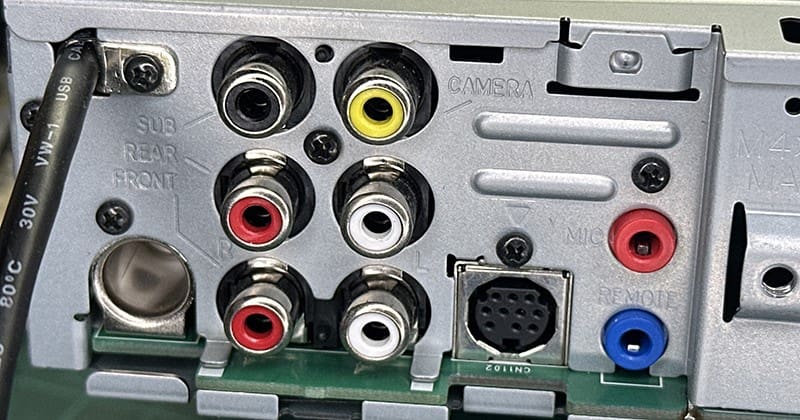
The radio should have built-in adjustable electronic crossovers to make filtering the audio information from each preamp output easy. The front and rear outputs should have, at a minimum, a high-pass filter that’s adjustable between 80 and 250 hertz for the midrange speakers in the vehicle. Ideally, there should be separate crossovers for the front and rear outputs. Years ago, cars and trucks had relatively small speakers in the dash, so they needed higher crossover frequencies to make them sound good.
The subwoofer output should have a low-pass filter with similar crossover points. If the attenuation slopes are shallow, a slightly lower 70 or 60-hertz filter might be needed. Ideally, the crossover should have a -24 dB/octave slope.
The subwoofer output should also have polarity adjustments. Depending on the subwoofer installation location or the choice of filter slopes, the polarity might need to be reversed. Finally, the subwoofer output should have a dedicated level control. This makes it easy to turn the bass up or down to suit a specific genre of music, track, or the listener’s mood.
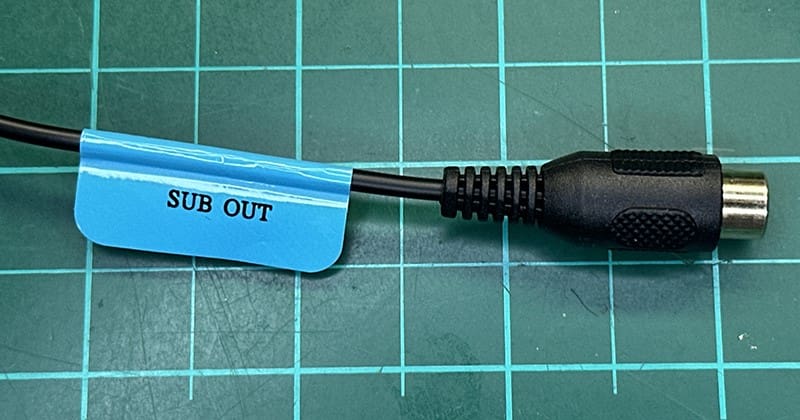
Pre-Amp Output Signals
Depending on the radio you are looking at, the preamp outputs might be capable of producing anywhere between two and five volts of output. To achieve this, the volume on the radio needs to be at its maximum, and the music you are playing needs to be recorded at the highest possible level. In other words, it almost never happens.
Nevertheless, more preamp output voltage allows your installer to turn down your amplifier’s sensitivity (gain) control. This usually improves the system’s signal-to-noise ratio. If you are at moderate volume levels on a 2-volt rated source unit, it might produce around 30 millivolts of signal. On a four- or five-volt capable source unit, that might be twice as high, at 60 to 70 millivolts.
It’s crucial to understand that the system shouldn’t play any louder with a two-volt source than a source unit capable of producing five volts on the preamp output.
Testing a Single Subwoofer Output Deck
The Sony XAV-AX8500 source unit is still on the BestCarAudio.com test bench. Let’s examine what happens to an amplifier’s preamp signal and output when there is only one preamp output.
We’ll set up the Sony radio and play a 50 Hertz signal into a Sony XM-1ES subwoofer amplifier connected to a two-ohm load. We’ll tap into the preamp signal to look at the voltage coming from the deck. Once we have that information, we’ll add a Y-cable so the preamp output feeds both inputs on the amp. We’ll follow this by checking the preamp signal voltage and analyzing the output of the amplifier again. To keep everything simple, we’ll set the volume on the source to have about 1 volt of signal out of the amp. The sensitivity level on the amp doesn’t matter to our measurements.
Single Subwoofer Output Measurements
OK, the volume is set at an arbitrary level of 31 out of 50. We see 0.4405 volts on the RCA output. The amplifier is producing 1.001 volts of output into a two-ohm load. Again, the latter is irrelevant to this topic. However, it makes some of the math simple and obvious.
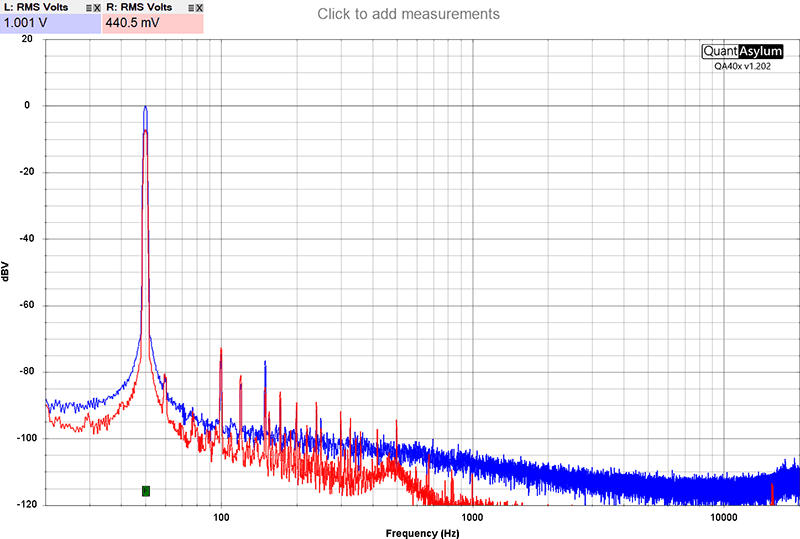
If you are a visual learner, perhaps playing white noise will help you see what’s happening. We played a -0.01 dB white noise track with the same volume setting. The results are below.
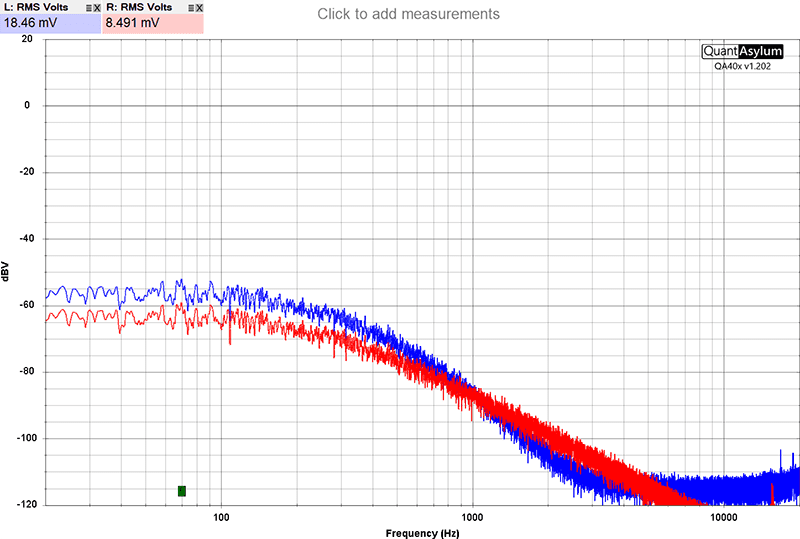
This information tells us how much gain the amp is providing and may also provide some information about the low-pass filter in the amp and head unit.
Dual Subwoofer Output Measurements
Now, let’s see what happens to both signals when we connect the single preamp subwoofer output to both inputs on the amplifier. We used a simple RCA Y-cable for this. The male end is connected to the subwoofer output RCA jack, and the RCA cables are connected from the output of the Y-cable to both inputs on the amplifier. Nothing else has changed. The volume on the source unit is still at 31, and the gain control on the amplifier hasn’t been touched.
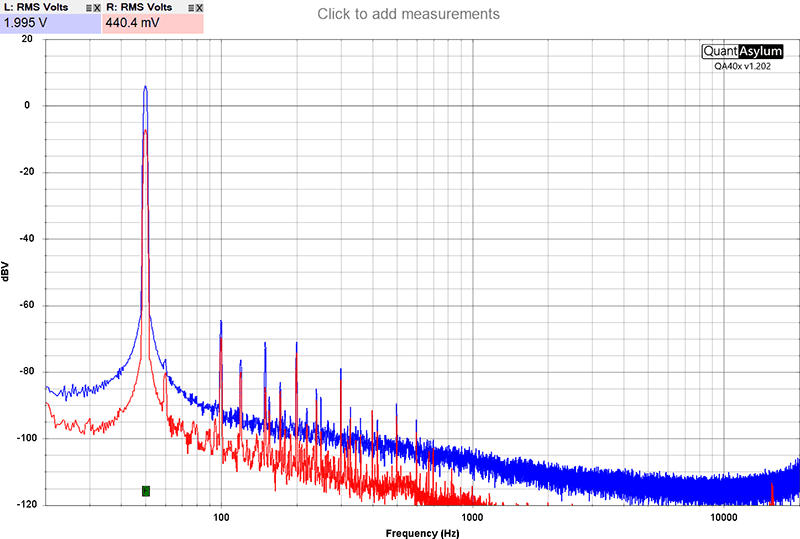
Output of the radio dropped from 0.5505 volts to 0.5504. That represents a decrease of 0.001972 dB V. That would be impossible to hear under any circumstances. The output of the amplifier has now increased to 1.995 volts. That’s an increase of 5.912 dB V or roughly 50%.
If you want to consider the amplifier output voltage increase in terms of power, the amp produced 0.501001 watts into a two-ohm load. When we split the signal from the source unit and fed it to both inputs, the amplifier output increased to 1.990013 watts. To keep things simple, we have four times the power.
Here is the white noise waveform with both RCA jacks connected to the head unit.
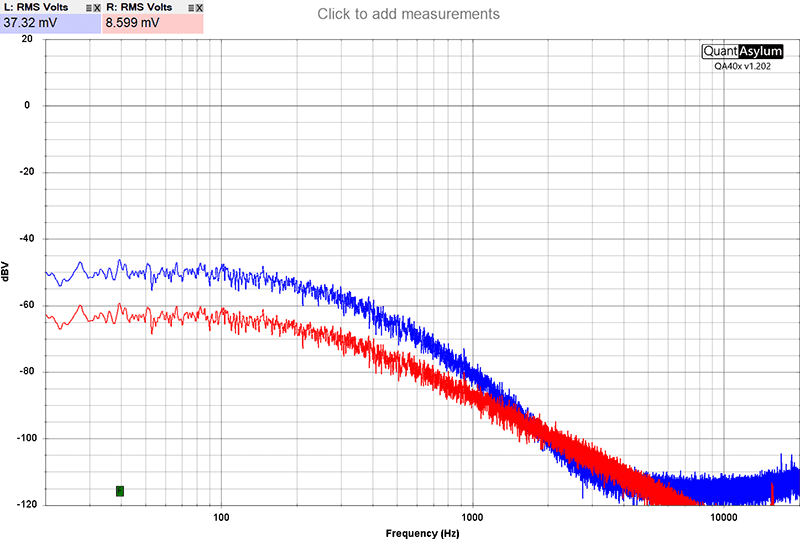
Why Did the Output Increase?
So, why is the amp producing more voltage and making more power? Inside the amp, the signal on the left and right RCA connections are summed together. Suppose there is 440.5 millivolts on each channel; that adds up to the equivalent of 881 millivolts. The amplifier then increases the amplitude of that signal. It’s the same effect as turning up the volume to the same level.
Does the Amp Produce More Power?
So, will more voltage on the inputs to the amp result in it making more power? Absolutely! More voltage always results in more power. This is true unless the amplifier reaches its maximum output voltage or current delivery limits. This last statement is the key to understanding the difference between using one or two RCA input connections.
The amplifier’s maximum power output capabilities are based on its design, the power you can feed it, and the load (speaker) impedance connected to the outputs. The sensitivity (gain) control allows your installer to adjust the amp to produce this maximum output with different amounts of voltage.
If your source unit has a single RCA preamp output connection, the gain on the amp will need to be about six dB higher to produce the same output as if you had two RCA outputs. The maximum possible output power remains constant. In the case of a subwoofer amplifier, we never hear noise, as it’s typically only audible in the high-frequency region. As such, the amp will sound precisely the same with either configuration.
Y-Splitters and RCA Preamp Output Impedance
In preparing to answer this question, we’ve seen dozens of comments stating that using a Y-cable will reduce the source unit’s output voltage. Well, we’ve now measured that in real-world conditions. They are right. The output drops by 0.02771%. Could you detect the sarcasm? No? Sorry, we’ll try harder next time.
There is very little current flowing in an RCA cable. If we had to try to calculate the amount, we’d guess, at this arbitrary 0.4405-volt level, it’s less than 0.000044 amps. As such, when you split the signal into two connections, the current might increase to 0.000088 amps. That’s still effectively nothing in the grand scheme of things. For all intents and purposes, preamp output voltages don’t decrease audibly when Y-cables are used.
Sony Subwoofer Amp Input
We’ll review a little bonus related to the Sony XM-1ES monoblock subwoofer amp we used for this test. Amongst the controls on the top panel is a switch labeled Input Mode. The selection options are 1 or 1+2. In the 1+2 mode, the amp sums the signal on input 1 with the signal on input 2. If you have 0.4405 volts on each, the amplifier’s preamp stage output is 0.881 volts. If your installer puts the Input Mode switch into the 1 position, the amplifier internally connects input 2 to input 1. This is the same as having 0.4405 volts on each. The result is that the amp sends 0.881 volts to the driver stage.
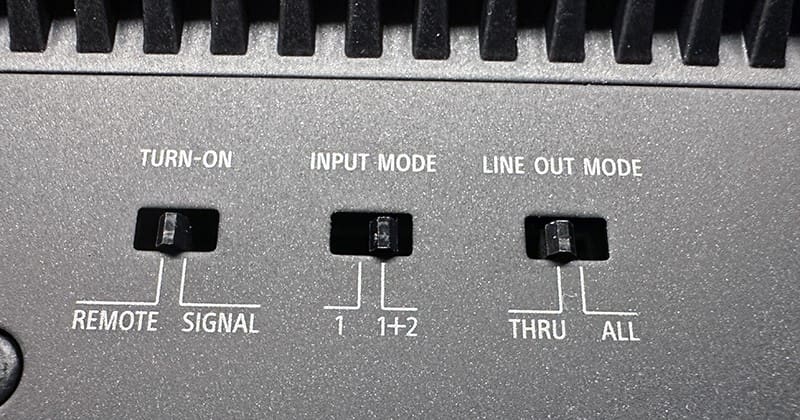
Why Do Some Radios Only Have One Subwoofer Output?
I am sure you are wondering why a radio might only have a single RCA output jack. Surely, the manufacturer can afford to add another connector or cable, right? They most certainly can. However, that’s never the issue with name-brand source units. The problem is real estate. Look at the above image of the back of the radio with the RCA jacks on the chassis. That block of six RCA jacks is sold as a single unit. The cost and complexity of adding a seventh jack would necessitate a complete redesign of the chassis, the radio circuit board, and new tooling for the seven-position block. Even switching to a different connection option for the camera input adds costs. There’s no detriment to performance with a single RCA output jack for the subwoofer, so why spend a lot of money on adding a second?
What Happens When You Have a Deck with One Subwoofer Output Jack?
If you have a Sony deck with a single subwoofer preamp output and are using the Sony Mobile ES XM-1ES amplifier, have your installer run a single RCA cable and set the amp Input Mode switch to 1. If you have an amp with no signal summing, use a single RCA cable and have your installer set the gain correctly. Alternatively, your installer can add a Y-cable at the radio and run a pair of RCA cables to the amp. Once again, they should set the gain appropriately. You will get the same output from the amp in any of these conditions. There is no audible difference. There will be no efficiency benefits. Most importantly, the radio won’t care.
Drop by a local specialty mobile enhancement retailer today to find out what source units, amplifiers, and subwoofers are available to upgrade the sound in your car, truck, or SUV. Most importantly, don’t fret about how many outputs the source unit has. This design decision has no bearing whatsoever on system performance.

